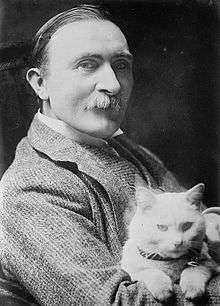Philip Burne-Jones
Sir Philip William Burne-Jones, 2nd Baronet (1 October 1861 – 21 June 1926)[1] was the first child of the British Pre-Raphaelite artist Sir Edward Burne-Jones and his wife Georgiana Macdonald. He became a well-known painter in his own right, producing more than 60 paintings, including portraits, landscapes, and poetic fantasies.


Life and career
He was born in London, England in 1861 and was educated at Marlborough College. He attended Oxford University for two years, but quit. To appease his parents for this failure, he agreed to take lessons in painting in London.
Philip did study painting seriously. His skill was great and he exhibited his work in well-known galleries in London and Paris. The Royal Academy exhibited his work eleven times between 1898 and 1918, and his work was also shown in the Paris Salon of 1900. There he exhibited his portrait of his father, now in the National Portrait Gallery. He painted portraits of many well-known persons of the time.
His most famous work, The Vampire (1897), depicting a woman straddling an unconscious man, was believed to have been modelled by the actress Mrs Patrick Campbell, with whom Burne-Jones had been associated romantically.[2] The painting also inspired his cousin Rudyard Kipling's poem of the same name. Robert G. Vignola's The Vampire (1913) features "The Vampire Dance" which is directly influenced by the painting.[3]
Having a famous father was difficult for him, and it was Philip's fate in life that his work was often compared unfavourably with that of his father.
Upon his father's death in 1898, Philip succeeded to the title of baronet that had been bestowed on his father during 1894. It is said that his father had accepted the title only because Philip was keen to inherit it.
Burne-Jones visited the United States during 1902, where he was popular in fashionable society. He lived most of his life in London, where he died in 1926.
References
- http://www.leighrayment.com/baronetage.htm
- "Shaw's Vampire". Time Magazine. 1940-04-22. Retrieved 2008-08-09.
- James Card, Seductive cinema: the art of silent film, Knopf, 1994, p.183
External links
| Wikimedia Commons has media related to Philip Burne-Jones. |
- Works by or about Philip Burne-Jones at Internet Archive
- Philip Burne-Jones exhibition catalog
- Philip Burne-Jones at Library of Congress Authorities, with 8 catalogue records
| Baronetage of the United Kingdom | ||
|---|---|---|
| Preceded by Edward Coley Burne-Jones |
Baronet (of Rottingdean and of the Grange) 1898–1926 |
Extinct |